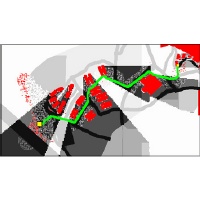NREC and RAND have directly connected field tested robotic mobility models and control software to high-resolution simulation models. The work resulted in linkage of NREC Field D* dynamic planning algorithms with the RAND-based Janus and Joint Conflict and Analysis Tactical Simulation (JCATS) force-on-force simulation environments. The linkages include NRECs fractal terrain generation algorithms (for generating very high-resolution terrain appropriate for robotic system mobility simulation) and intervisibility algorithms (for determining visibility of targets to assets and assets to threats).
In the project’s first phase, NREC developed a highly reusable Robotic Simulation Support module to interface the Field D* planner with the Janus Force on Force simulator. Because the base resolution of the Janus terrain was lower than is necessary to accurately simulate robotics behavior, we used a Fractal Terrain Generator to add the appropriate roughness for each terrain type.
To ensure the additions produced by the generator accurately reflected the true difficulty of the terrain; we also developed an easy-to-use GUI-based tool which allows the RAND analysts to adjust the Terrain Generator’s input parameters, ensuring the validity of the simulation. Following development, successful integration tests on relevant simulation scenarios were run at RAND’s facilities.
In the second phase, NREC adapted the software module to connect to the JCATS simulator as well. Again, NREC and RAND successfully tested the integration on relevant simulation scenarios. NREC also began designing a system to bring new cooperative robotic behaviors to the simulator.
Currently, we are working to develop and integrate those behaviors with RAND’s simulators.


